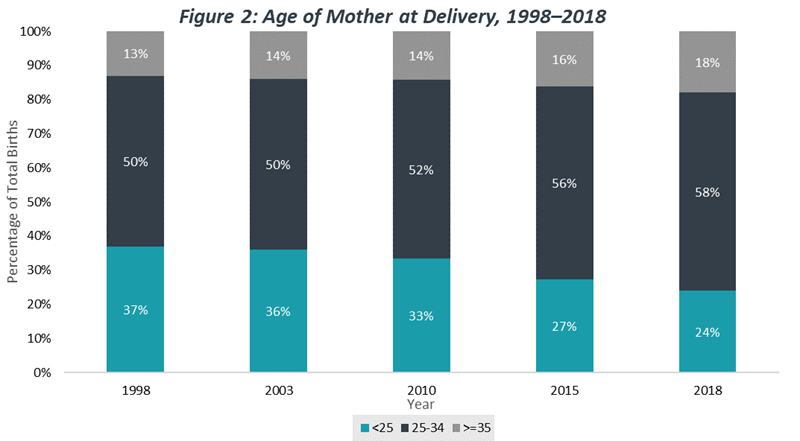
In May 2019, the Centers for Disease Control and Prevention (CDC) announced that in 2018 the US experienced the lowest birth rate in its history, continuing the last decade’s downward trend. While the overall US population is increasing, the number of births in the US has dropped to a 32-year low (see figure 1). The data is alarming for inpatient facilities that consider maternal and children’s health to be core community service offerings, and for community obstetrics (OB) and pediatric providers facing decreasing demand for their services.

While overall births are decreasing, the average age of first-time mothers is increasing. From 2000 to 2014, the proportion of first-time mothers aged 30–34 rose 28% (from 16.5% to 21.1%), and first births to women aged 35 and over rose 23% (from 7.4% to 9.1%) (see figure 2). Within that 14-year period, the most pronounced increases in maternal age occurred more recently, from 2009 to 2014.

Maternal Care Implications
Today’s lowered demand and the projected continuation of the decreasing birth rate combined with increasing maternal age have numerous implications, including:
- Labor and delivery (L&D) units will be competing for fewer deliveries.
- A higher proportion of births will continue to tip into the high-risk category, which has implications for cesarean section rates and low-birthweight babies.
- Demand for maternal-fetal medicine (MFM) specialists and neonatologists will increase. Shortages in these specialties may lead to telemedicine opportunities.
- Consumer preference will be king. Hospitals and physician groups will no longer be able to rely on organic growth; instead, they will need to offer patient services and experiences that are superior to those of their competitors.
- Hospitals in certain markets will need to rely on Medicaid patients and perhaps develop Medicaid-specific strategies to maintain program volumes while ensuring service line financial viability is not compromised.
Hospital administrators, service line administrators, and physicians should be actively considering strategies to maintain market position and develop differentiators or risk being left behind.

